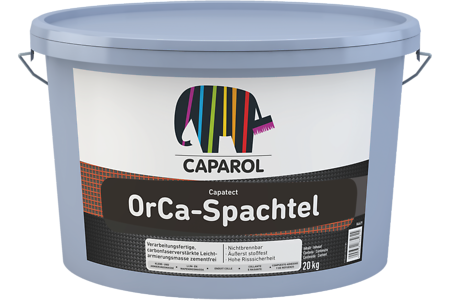Field of Application
Reinforcement compound for use within the Capatect ETICS System B. Surfacer for plaster renovation. Suitable for mounting edge profiles.
Material Properties
- Ready-to-use and easy to apply
- Excellent adhesion
- Good fresh mortar stability
- Low shrink tension
- Water dilutable
- Water repellent
Packaging/Package Size
20 kg bucket and 600 kg BigDrumColours
Light beige
Storage
Cool, dry, frost-free and protected from direct sunlight.Density
approx. 1.3 kg/dm3Diffusion-equivalent air layer thickness sdH2O
approx. 0.5 m as per DIN EN 7783; for a 3 mm thick layer, Class V2 (medium) as per DIN EN 1062Water permeability (w-value)
< 0.05 kg/(m2 · h0.5) as per DIN EN 1062, Class W3 (low)Fire behaviour
German classification "schwerentflammbar" – B1 (flame-retardant)Consistency
paste-like
Shock resistance / Impact strength
up to 15 joule for a 3 mm reinforcement layer thicknessProduct No.
699Note
These parameters represent average values, which may differ slightly from batch to batch caused by natural fillers and components.
May not be coated by mineral based reinforcements and renders.
Substrate Preparation
Abrade all surface irregularities and offset at butt joints of EPS boards to achieve an even surface. Remove adherent abraded dust. Protect window sills and other attached parts.
All substrates must be load-bearing, dry, even (DIN 18202 or 18203), clean and free of adhesion-reducing residues.
Preparation of Material
The material is ready to use. Stir up shortly before application.
Adjust to working consistency with a very small amount of tap water, only if necessary.
Method of Application
Apply Capatect ZF-Spachtel 699 onto the front side of the thermal insulation boards in the width of the reinforcing fabric stripe "Capatect-Gewebe 650/110". Embed the reinforcing fabric thoroughly - stripe by stripe - into the freshly applied and still wet surface with an overlap of approx. 10 cm. A subsequent coat of Capatect 699 must be immediately applied (wet-on-wet), to guarantee a complete embedding of the fabric and a total reinforcement layer thickness of approx. 2-3 mm. A layer thickness up to 5 mm is possible. The reinforcing fabric should be embedded in the center of the layer. For layer thickness ≥ 4mm it is best placed in the outer third of the reinforcement layer - but it must be well covered.
Note: To achieve an uniformly flat surface of Capatect ZF-Spachtel 699 on mineral wool boards apply first a 1 - 2 mm thick base coat of Capatect ZF-Spachtel without fabric to stabilize the surface of the mineral wool. After curing apply a second coat of Capatect ZF-Spachtel 699 and embed the Capatect-Gewebe 650/110 into this coat.
Corners of the building:
Place all edge protection elements and corner bars by using an adequate quantity of adhesive mortar prior to the embedding of the overall reinforcement and smooth the surface.
Note: If Capatect corner bars with reinforcing fabric are placed, Capatect-Gewebe 650 (reinforcing fabric) should be applied only up to the external corner.
In case of using bars without mesh stripes, the overall reinforcing has to overlap the edge area for approx 10 cm.
Arround all openings like windows and doors additional diagonal oriented reinforcing mesh stripes are to place at each opening corner and additional stripes inside the reveal corners. This measure can be substituted by using the three dimensional mesh elements "Capatect-Sturzeckwinkel 651/20".
Consumption
per mm layer thickness: Approx. 1.3 kg/m2
This figure may vary depending on substrate or application conditions.
Application Conditions
Processing temperature: +5 °C to +30 °C during application and curing for the material, substrate and ambient air.Do not apply in direct sunlight or on sun heated substrates, during strong wind, fog or rain, high relative humidity or imminent rain or frost.
Drying/Drying Time
at 20 °C and 65% RH: surface dry after 24 hours; completely cured and ready for stress after 3 days. Check the entire curing before further processing with organic based render - depending on weather conditions at the earliest after 2 to 3 days. Mineral based render is unfit for this purpose.Tool Cleaning
immediately after use with water.Special Risks (Hazard Note) / Safety Advice (Status as at Date of Publication)
Not a hazardous substance or mixture.
Precautionary statements
P102: Keep out of reach of children.
EUH208: Contains mixture of: 5-chloro-2-methyl-2H-isothiazolin-3-one [EC no. 247-500-7] and 2-methyl-2H-isothiazol-3-one [EC no. 220-239-6] (3:1), 2-ydroxypropylneodecanoat, 2-methyl-2H-isothiazol-3-one.
Volatile organic compounds as per Directive 2004/42/EC: < 1 %; < 10 g/l
May produce an allergic reaction.
Ensure good ventilation during use and drying. Do not eat, drink or smoke while using the product. In case of contact with eyes or skin, immediately and thoroughly rinse with water. Do not allow product to enter drains, waterways or soil. Clean utensils immediately after use with soap and water. Do not breathe spray dust. Use A2/P2 combination filter for paint spraying.
Disposal
Materials and all related packaging must be disposed of in a safe way in accordance with the full requirements of the local authorities.
In Germany: Dispose containers with residues of liquid product via waste collection point accepting old paints and enamels. Dispose dried/hardened product residues as construction site/demolition/municipal or domestic waste.
Only completely emptied containers should be given for recycling.
Risk and Transportation Markings
Environmentally hazardous: noGiscode
BSW20Product Code Paints and Enamels
M-DF02 Water-based paints (outdated)
Further Details
See Material Safety Data Sheets.Assessments and approvals:
Germany: Z-33.41-130 Z-33.42-131 Z-33.43-132 Z-33.49-1071
Europe: ETA-08/0304 ETA-10/0160
Customer Service Centre
Tel.: +49 6154 71-71710Fax: +49 6154 71-71711
e-mail: kundenservicecenter@caparol.de
International Distribution: Please see www.caparol.com







